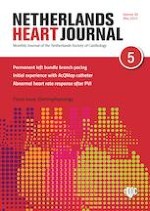-
This is the first publication describing detailed left bundle branch area pacing (LBBAP) implantation characteristics of patients receiving their first pacemaker in the Netherlands.
-
There is a learning curve for LBBAP implantation, even in a centre with cardiologists experienced with His bundle pacing, which flattens after 40–50 procedures.
-
Although QRS duration remains prolonged, LBBAP largely maintains left ventricular synchrony at values close to intrinsic sinus rhythm with normal atrioventricular conduction and narrow QRS.
-
In patients with left bundle branch block, LBBAP reduces QRS duration and normalises the QRS vector in the transverse plane.
-
QRS area and V6 R‑wave peak time are significantly shorter during LBBP compared to left ventricular septal pacing.
Introduction
Methods
Patient selection
Implantation procedure
Pacing and capture definitions
Electrical measurements
Data collection
Safety endpoints
Statistical analysis
Results
Baseline characteristics
Characteristics (n = 80) | Mean ± SD or n (%) |
|---|---|
Male sex | 47 (59%) |
Age (years) | 74 ± 10 |
Medical history | |
– Hypertension | 46 (58%) |
– Diabetes mellitus | 16 (20%) |
– Atrial fibrillation | 33 (41%) |
– Coronary artery disease | 30 (38%) |
– LVEF < 50% | 18 (23%) |
Echocardiographic parameters | |
– LVEF (%) | 53 ± 10 |
– LV end-diastolic diameter (mm) | 51 ± 7 |
– LV end-systolic diameter (mm) | 37 ± 7 |
– IVS thickness (mm) | 10 ± 1 |
Electrocardiographic parameters | |
– Heart rate (bpm) | 67 ± 20 |
– QRS duration (ms) | |
a. all patients | 116 ± 31 |
b. intrinsic ventricular conduction | 95 ± 13 (n = 45) |
c. Other (escape, LBBB/RBBB, paced) | 143 ± 26 (n = 35) |
Pacemaker indication | |
– Sinus node dysfunction | 27 (35%) |
– Atrioventricular block | 32 (41%) |
– Atrial tachyarrhythmia requiring ablation | 8 (10%) |
– Heart failure and prolonged QRS duration | 10 (13%) |
